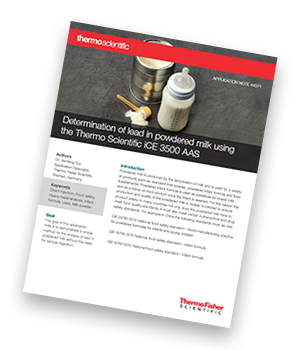The goal of this application note is to demonstrate a simple method for the analysis of lead in powdered milk without the need for sample digestion using atomic absorption spectroscopy (AAS).

 Introduction
Introduction
Powdered milk is produced by the dehydration of milk and is used for a variety of products such as standard milk powder, powdered infant formula and food supplements. Powdered infant formula is used as a substitute for breast milk and as a follow on food product once the infant is weaned. For this reason the production and quality of the powdered milk is closely monitored to ensure product safety. In many countries not only does the powdered milk have to meet food quality standards, it must also meet certain nutraceutical and drug safety standards.
Some such standards specify that lead must not be present in infant formula at concentrations greater than 0.15 mg·kg-1. If the infant is exposed to concentrations greater than this then possible effects will
include damage to the central nervous system, digestive system as well as the hematopoietic function of bones.
Instrumentation
The Thermo Scientific™ iCE™ 3500 Atomic Absorption Spectrometer (AAS) was used for the analysis, which is a dual atomizer with flame and graphite furnace option. The graphite furnace was used for this analysis.
Method development
For initial method development, a mixture containing ammonium dihydrogen phosphate (APD) and palladium nitrate was used as matrix modifier, which avoids the influence of the matrix effectively as well as the loss of lead during the ashing procedure in all kinds of milk powder.
For maximum extension of the number of uses of the graphite tube, a certain amount of compressed air was added during the pre-ashing procedure to remove the deposition of carbon in the graphite tube.
Results
GBW08509a national standard skimmed milk powder was selected as the reference material that was used to control the accuracy of the developed analysis method. Two kinds of real milk powder samples were spiked and analyzed to verify the recovery of the method. The analysis results of GBW08509a indicate that the reproducibility of the measurement between 100.4% – 101.3% for lead is quantitative and close to the standard recommended values. Furthermore, the precision of the two parallel reference materials is 0.5%.
Discussion
Due to its material properties, the prepared milk powder sample solutions should stand for more than 5 hours to create a stable emulsion. Once a stable emulsion has been formed, an appropriate temperature needs to be maintained in order to avoid fermentation. The solutions can be retained for over 48 hours without significant changes.
Conclusion
This application note has shown that the Thermo Scientific iCE 3500 AAS is an ideal tool for analysis of Pb in milk powder samples with direct injection. With its high sensitivity and robustness, the instrument is easily capable of accurately and precisely measuring Pb in a single analysis method. This method has a very simple sample pre-treatment process, a direct injection process and rapid as well as high sensitivity performance at the same time. In summary, determination of Pb in a wide range of milk powder sample types can be efficiently and rapidly performed using the iCE 3500 AAS.




